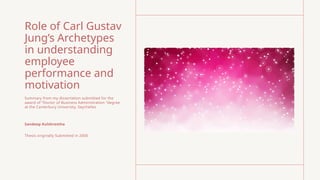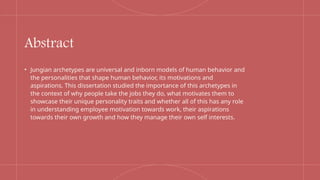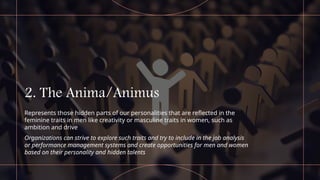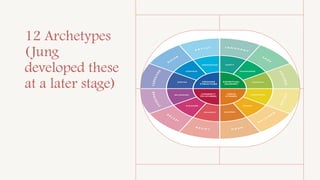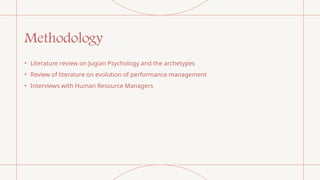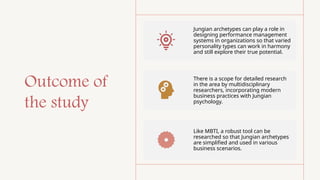Role of Carl Gustav Jung’s Archetypes in understanding employee performance and motivation
- 1. Role of Carl Gustav Jung’s Archetypes in understanding employee performance and motivation Summary from my dissertation submitted for the award of “Doctor of Business Administration "degree at the Canterbury University, Seychelles Sandeep Kulshrestha Thesis originally Submitted in 2006
- 2. Abstract • Jungian archetypes are universal and inborn models of human behavior and the personalities that shape human behavior, its motivations and aspirations. This dissertation studied the importance of this archetypes in the context of why people take the jobs they do, what motivates them to showcase their unique personality traits and whether all of this has any role in understanding employee motivation towards work, their aspirations towards their own growth and how they manage their own self interests.
- 4. 1. The Persona: our outwardly face that is shown by us to the world • All of us have a persona that is distinct from who we are. A persuasive sales executive or a CEO would exemplify persona, as anyone else does as well. Organizations can create systems and platforms for people to explore the persona.
- 5. 2. The Anima/Animus Represents those hidden parts of our personalities that are reflected in the feminine traits in men like creativity or masculine traits in women, such as ambition and drive Organizations can strive to explore such traits and try to include in the job analysis or performance management systems and create opportunities for men and women based on their personality and hidden talents
- 6. 3. The Shadow • Represents the primitive nature of humans. It may include laziness, emotional sensitivity, personal power, biases, ego, jealousy etc. Organizations can drive initiatives where these traits in people are acknowledged and balanced out through modern practices like Emotional Intelligence and Self Analysis.
- 7. 4. The Self Self in Jungian worldview is akin to self – actualization and. Jung mentioned that “selfhood” is the ultimate aim of every individual and is an instinctual foundation Organizations can make efforts in bringing policies and processes that nurture the feeling of safety and honing up people’s talents, so that their “selfhood” is an achievable goal, the space and thinking where there is autonomy, while being part of a wider system.
- 8. 12 Archetypes (Jung developed these at a later stage)
- 9. Methodology • Literature review on Jugian Psychology and the archetypes • Review of literature on evolution of performance management • Interviews with Human Resource Managers
- 10. Outcome of the study Jungian archetypes can play a role in designing performance management systems in organizations so that varied personality types can work in harmony and still explore their true potential. There is a scope for detailed research in the area by multidisciplinary researchers, incorporating modern business practices with Jungian psychology. Like MBTI, a robust tool can be researched so that Jungian archetypes are simplified and used in various business scenarios.
- 11. Thank You Dr Sandeep Kulshrestha Leadership and Well-being coach. Human Resource Professional. Professor of Human Resources and Positive Psychology Email: kulsh.Sandeep@gmail.com

